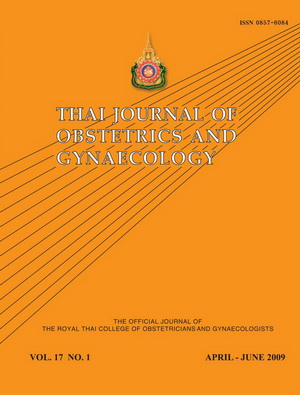Prevalence and Predictors of Abnormal Cervical Cytology in HIV-Infected Patients at the Anonymous Clinic, Chonburi Hospital
Main Article Content
Abstract
Objective: To categorize prevalence and predictors of abnormal cervical cytology among HIV-infected women at the anonymous clinic, Chonburi hospital.
Method: We screened 280 non-pregnant HIV-infected women accessing HIV/AIDS care service at the anonymous clinic, Chonburi hospital. We collected cervical specimens for cytological analysis by conventional Papanicolaou smear (Pap smear). Multivariate logistic regression analysis was employed and calculated based on following factors: sociodemographic, CD4 + cell counts, medical, sexual variables and gynecologic history.
Results: Prevalence of abnormal cervical cytology from Pap smear in HIV-infected women was 21.3%(60/280), of which 0.7%(2/280) had atypical squamous cells exclude high grade lesion (ASC-H), 6.4%(18/280) had low grade squamous intraepithelial lesion (LSIL), 12.1%(34/280) had high-grade squamous cell intraepithelial lesion (HSIL) and 2.1%(6/280) had squamous cell carcinoma (SCCA). Multivariate logistic regression analysis suggested that number of parity, lifetime sexual partners, age of first intercourse at 18 years or younger and lowest CD4+ cell count were significantly associated with the presence of the abnormal cytological lesions (adjusted OR: 1.515, 95%CI 0.036-2.214, p=0.032, adjusted OR: 2.938, 95%CI 1.874-4.607, p<0.001, adjusted OR: 0.401, 95%CI 0.191-0.842, p=0.016, adjusted OR: 0.993, 95%CI 0.990-0.996 p<0.001, respectively). In addition to these factors, univariate analysis also identified additional factors significantly associated with the presence of abnormal cytological lesions (≥ASC-H). Such factors were duration of HIV-infection, current CD4+ cell counts, and antiretroviral drug therapy.
Conclusion: In our population, the independent predictors of abnormal Pap smear in HIV infected women were number of parity, lifetime sexual partners, age of first intercourse at 18 years or younger and lowest CD4+ cell counts.

